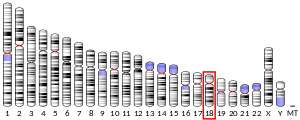PHLPP (gene)
PH domain and leucine rich repeat protein phosphatase, also known as PHLPP, is an enzyme which in humans is encoded by the PHLPP gene.[5]
See also
References
Further reading
- Nakajima D, Okazaki N, Yamakawa H, et al. (2003). "Construction of expression-ready cDNA clones for KIAA genes: manual curation of 330 KIAA cDNA clones". DNA Res. 9 (3): 99–106. doi:10.1093/dnares/9.3.99. PMID 12168954.
- Nagase T, Ishikawa K, Miyajima N, et al. (1998). "Prediction of the coding sequences of unidentified human genes. IX. The complete sequences of 100 new cDNA clones from brain which can code for large proteins in vitro". DNA Res. 5 (1): 31–9. doi:10.1093/dnares/5.1.31. PMID 9628581.
- Shimizu K, Okada M, Takano A, Nagai K (2000). "SCOP, a novel gene product expressed in a circadian manner in rat suprachiasmatic nucleus". FEBS Lett. 458 (3): 363–9. doi:10.1016/S0014-5793(99)01190-4. PMID 10570941.
- Strausberg RL, Feingold EA, Grouse LH, et al. (2003). "Generation and initial analysis of more than 15,000 full-length human and mouse cDNA sequences". Proc. Natl. Acad. Sci. U.S.A. 99 (26): 16899–903. doi:10.1073/pnas.242603899. PMC 139241. PMID 12477932.
- Ota T, Suzuki Y, Nishikawa T, et al. (2004). "Complete sequencing and characterization of 21,243 full-length human cDNAs". Nat. Genet. 36 (1): 40–5. doi:10.1038/ng1285. PMID 14702039.
- Gerhard DS, Wagner L, Feingold EA, et al. (2004). "The status, quality, and expansion of the NIH full-length cDNA project: the Mammalian Gene Collection (MGC)". Genome Res. 14 (10B): 2121–7. doi:10.1101/gr.2596504. PMC 528928. PMID 15489334.
- Gao T, Furnari F, Newton AC (2005). "PHLPP: a phosphatase that directly dephosphorylates Akt, promotes apoptosis, and suppresses tumor growth". Mol. Cell. 18 (1): 13–24. doi:10.1016/j.molcel.2005.03.008. PMID 15808505.
- Zhang Y, Wolf-Yadlin A, Ross PL, et al. (2005). "Time-resolved mass spectrometry of tyrosine phosphorylation sites in the epidermal growth factor receptor signaling network reveals dynamic modules". Mol. Cell. Proteomics. 4 (9): 1240–50. doi:10.1074/mcp.M500089-MCP200. PMID 15951569.
- Nusbaum C, Zody MC, Borowsky ML, et al. (2005). "DNA sequence and analysis of human chromosome 18". Nature. 437 (7058): 551–5. doi:10.1038/nature03983. PMID 16177791.
- Brognard J, Sierecki E, Gao T, Newton AC (2007). "PHLPP and a second isoform, PHLPP2, differentially attenuate the amplitude of Akt signaling by regulating distinct Akt isoforms". Mol. Cell. 25 (6): 917–31. doi:10.1016/j.molcel.2007.02.017. PMID 17386267.
This article is issued from
Wikipedia.
The text is licensed under Creative Commons - Attribution - Sharealike.
Additional terms may apply for the media files.




